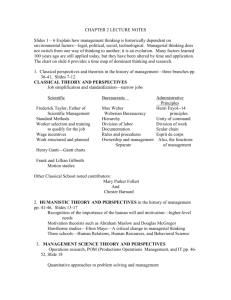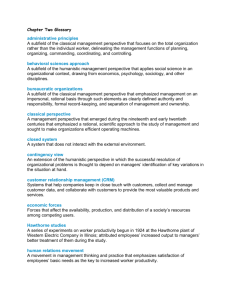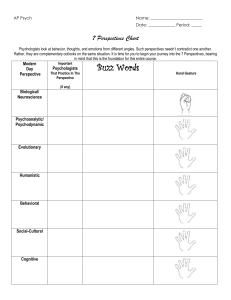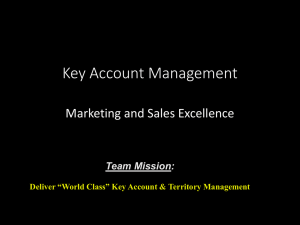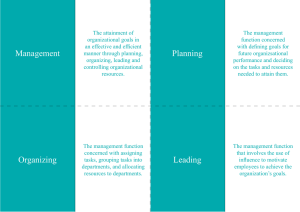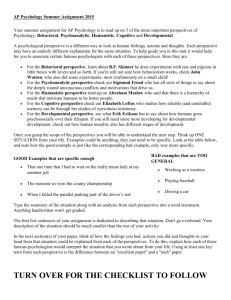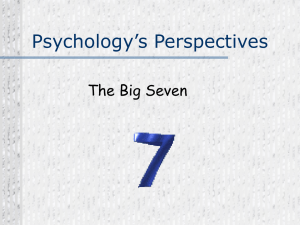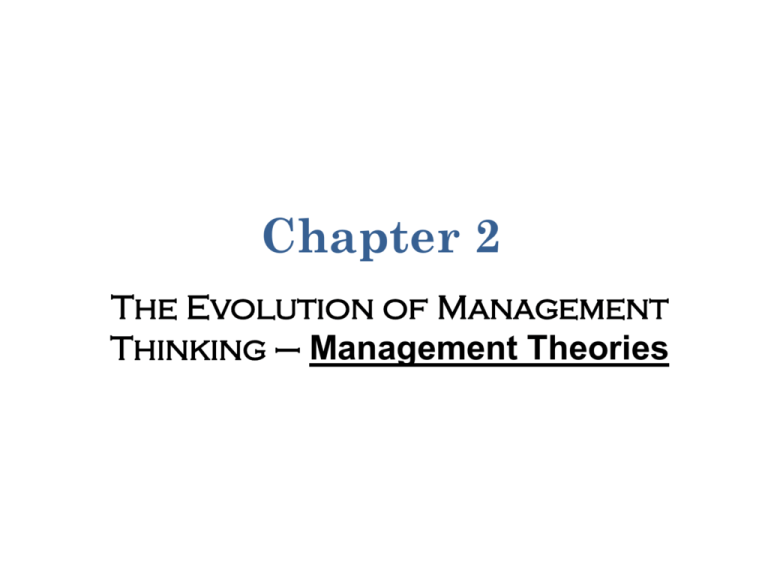
Chapter 2
The Evolution of Management
Thinking – Management Theories
Management and Organization
Studying management history helps your
conceptual skills
• Social Forces – aspects of a culture that guide
and influence relationships among people
• Political Forces – influence of political and legal
institutions
• Economic Forces – the availability, production,
and distribution of resources
2
Management Perspectives over Time
Classical Perspective
• Emerged during the 19th & early 20th Centuries:
– Rise of the factory system (= large organization)
– Issues regarding structure, training, and employee
satisfaction
• Large, complex organizations required new
approaches to coordination and control
• Three subfields:
1. Scientific management,
2. Bureaucratic organizations, and
3. Administrative principles
4
Classical Perspectives –
(1) Scientific Management
• Improve efficiency and labor productivity
through scientific methods
• Frederick Winslow Taylor proposed that workers
“could be retooled like machines”
• Management decisions would be based on precise
procedures based on study
• Henry Gantt developed the Gantt Chart to
measure and plan work
• Gilbreth pioneered time and motion studies to
promote efficiency
5
Characteristics of
Scientific Management
Characteristics of
Scientific Management
(continued)
Classical Perspectives –
(2) Bureaucratic Organizations
• Max Weber, a German theorist, introduced the concepts
• You should manage an organization on an impersonal, rational
basis through defined authority and responsibility, formal
recordkeeping, and separation of management and ownership
• Bureaucracy
• Organization depends on rules and records
• Managers use power instead of personality to delegate
• Although important productivity gains come from this
foundation, bureaucracy has taken on a negative tone
• DQ: Suppose you are a creative worker, and do not have much respect
on authority. Is a government job a right choice for your career?
8
Characteristics of Weberian Bureaucracy
Classical Perspectives –
(3) Administrative Principles
• Focused on the entire organization
• Henri Fayol, a French mining engineer, was a major
contributor – “General & Industrial Management”
• Identified 5 functions of MGMT: planning, organizing,
commanding, coordinating, and controlling
• 14 general principles of MGMT; many still used today:
– Unity of command: Each employee should have only one boss
– Division of work: Specialized employees produce more with the same
effort.
– Unity of direction: Similar activities should be grouped under one manager.
– Scalar chain: A chain of authority extends from the top to the bottom of an
organization, and should include every employee.
10
Humanistic Perspective:
(1) Early Advocates
• Understand human behaviors, needs, and
attitudes in the workplace
• Mary Parker Follett:
– Importance of people rather than engineering
techniques: contrast to scientific management
– Empowerment: facilitating instead of controlling
• Chester Barnard:
– Recognition of the informal organization
– Introduced acceptance theory of authority
11
Humanistic Perspective (continued):
(2) Human Relations Movement
• Effective work comes from within the employee
• Hawthorne studies were key contributor
• Human relations paid key variable in increasing
performance
• Employees performed better when managers
treated them positively
• Strongly shaped management practice and
research
12
Humanistic Perspective (continued):
(3) Human Resources Perspective
• From worker participation and considerate
leadership to managing work performance
• Combine motivation with job design
• Maslow and McGregor extended and challenged
current theories
– Maslow’s Hierarchy (Chapter 16)
– Theory X and Theory Y
13
Theory X and Theory Y
Theory X and Theory Y (continued)
Humanistic Perspective (continued):
(4) Behavioral Sciences Approach
• Scientific methods + sociology, psychology,
anthropology, economics… to develop theories
about human behavior and interaction in an org.
• Organizational Development (O.D.) – field that
uses behavioral sciences to improve organization
• Other strategies based on behavioral science:
– Matrix Organizations
– Self-Managed Teams
– Corporate Culture
– Management by Wandering Around
16
Quantitative Perspective
• Also referred to as Management Science (a.k.a. Operations
Research, MS/OR, Decision Science, Operations Mgmt, Supply Chain
Mgmt, Business Analytics, Business Intelligence)
• Use of mathematics & statistics to aid management decision
making; Enhanced by development and growth of the computer
• Operations & Biz Analytics focuses on a scientific analysis of
the physical production of goods and services BUSN 211, MGMT
371, MGMT 471
• Info. Tech./Info. Systems focuses on technology and software to
aid managers DATA 235, MGMT 280
• Quants – financial professionals who base their decisions on
complex quantitative analysis Financial Engineering
Recent Trends:
(1) Systems Thinking
• System: Set of interrelated parts that function as a whole to achieve
a common purpose (goal): Input Process Output
• The ability to see the distinct elements of a situation as well
as the complexities; The relationship among the parts form the
whole system
• Subsystems are parts of the system that are all
interconnected
• Synergy – the whole is greater than the sum of its parts:
1 + 1 = 3 instead of 2; Managers must understand subsystem
interdependence and synergy
• Self-Adaptation: Basic System + [Feedback + Control]
18
Systems Thinking and Circles of Causality
Recent Trends:
(2) Contingency View
• Every situation is unique, there is no universal
management theory
• Managers must determine what method will work
• Managers must identify key contingencies for the
current situation
• Organizational structure should depend upon
industry and other variables
Copyright ©2012 by South-Western, a division of Cengage Learning. All rights reserved.
20
Contingency View of Management
Recent Trends:
(3) Total Quality Management (TQM)
• Quality movement is strongly associated with
Japan
• The U.S. ignored the ideas of W. Edwards
Deming, “Father of the Quality Movement”
• TQM became popular in the 1980s and 90s
• Integrate high-quality values in every activity
22
Elements of TQM
Employee involvement (Toshiba)
Focus on the customer
Benchmarking
Process Improvement
Each process improvement
Improvement of the whole organization
Continuous improvement
23
Innovative Management:
Thinking for a Changing World
• Management ideas trace their roots to historical
perspectives
• New ideas continue to emerge to meet the
changing needs and difficult times
• The shelf life of trends is getting shorter and new
ideas peak in fewer than three years
24
Managing the Technology-Driven
Workplace
• Social Media programs – Company online community
pages, social media sites, microblogging platforms and
online forums
• Customer Relationship Management (CRM
Systems) – technology used to build relationship with
customers
• Outsourcing – Contracting functions or activities to
other organizations to cut costs
• Supply Chain Management (SCM Systems) –
Managing supplier and purchaser relationships to get
goods to consumers
Supply Chain for a Retail Organization
Sample Review Questions:
• Describe the major components of the classical perspectives.
•Describe the major components of the humanistic management
perspectives.
• Discuss the quantitative perspective and its current use in organizations.
• Explain the major concepts of systems thinking.
•Explain the major concepts of the contingency view.
•Explain the major concepts of the total quality management.
• Name contemporary management tools and some reasons management
trends change over time.
•Describe the management changes brought about by a technologydriven workplace, including the role of customer relationship
management, outsourcing, and supply chain management.
27

